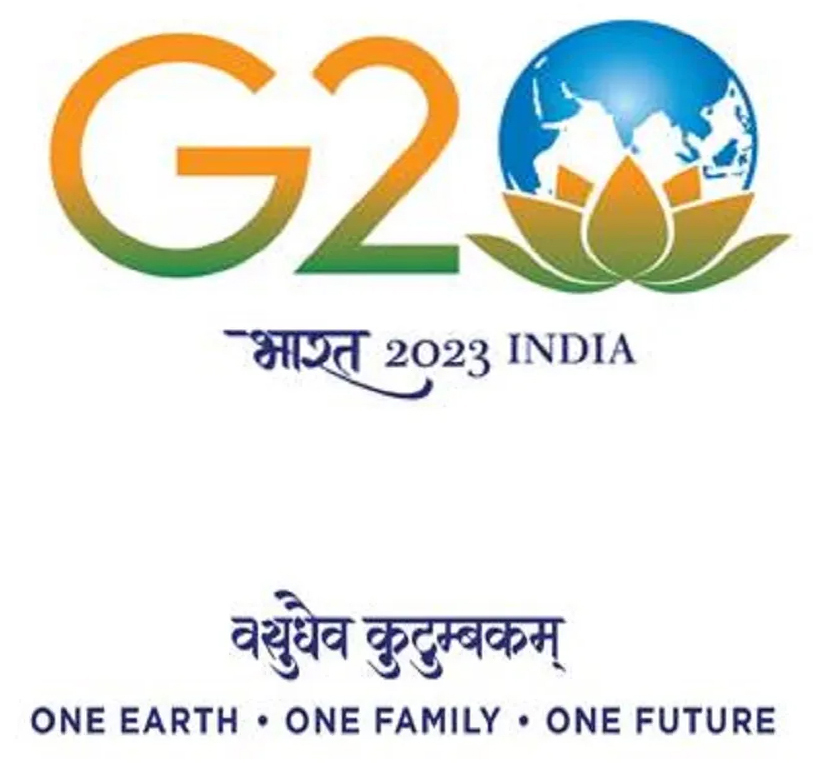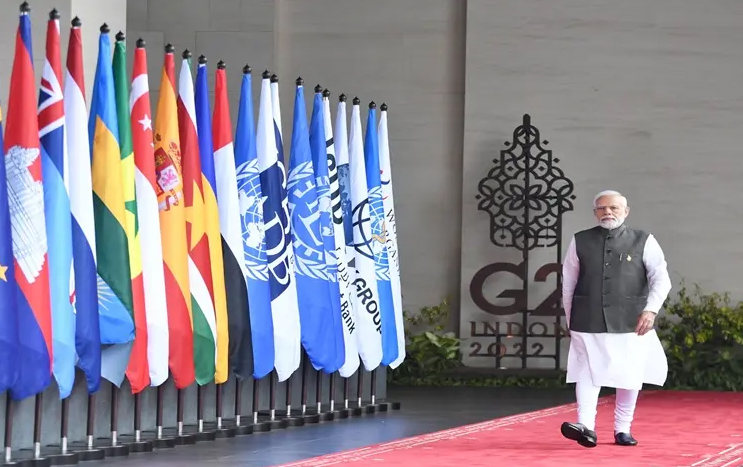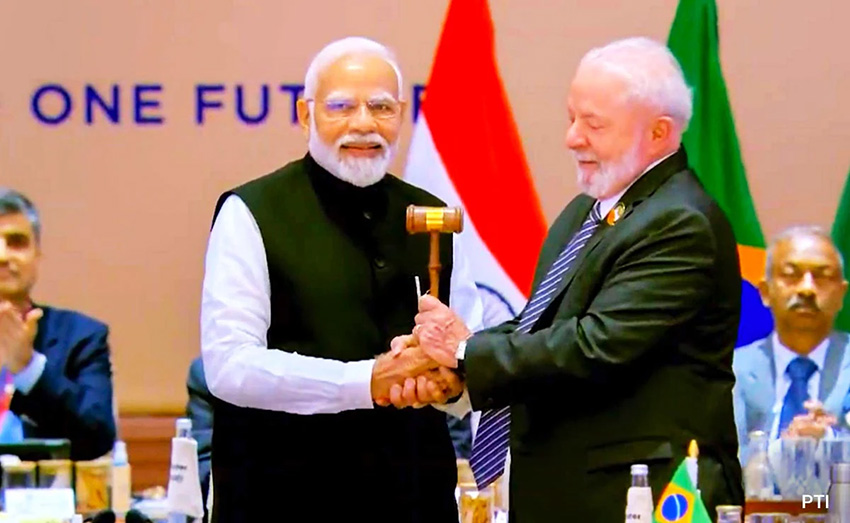G-20 & India Presidency
G-20 stands out as India's Diplomatic Achievement of the year
By R. Anil Kumar
- “India’s G-20 Presidency worked towards promoting the universal sense of one-ness. Hence our theme – ‘One Earth, One Family, One Future’” – Prime Minister Narendra Modi
- India demonstrated its leadership and vision in steering the G-20 agenda and addressing global challenges with innovative solutions
- India also pushed for the reforms of the UN Security Council to reflect the realities of the 21st century and ensure fair representation

Bangalore. As the year comes to an end, one can befittingly say that 2023 turned out to be a lucky year for Indian diplomacy with the G-20 standing out as the country’s diplomatic achievement of the year.
Through its G-20 presidency, India was able to get the most influential, powerful, and consequential countries of the world to gather around the table and discuss, agree on some of the most pressing issues concerning the world today.
As External Affairs Minister (EAM) S Jaishankar rightfully said, the G-20 is like the World Cup of diplomacy, where the biggest and strongest players come together.
“When we took the presidency, people did not have many expectations out of it. Through our G-20, we bridged all the divides, found a common ground for countries which were otherwise arguing among themselves, who found it very difficult to reconcile. But, we were able to bridge it,” the EAM said in his address at the Rotary Institute 2023 event in Bengaluru on December 17.

India assumed the G-20 Presidency on December 1, 2022.
The 18th G-20 Leaders’ Summit was held in New Delhi on September 9 and 10. It saw the unanimous adoption of the G-20 New Delhi Leaders’ Declaration, which demonstrated the commitment of the G-20 leaders to address global challenges in an inclusive, decisive and action-oriented manner.
The biggest takeaway of the declaration was that all 83 paras of the declaration were passed unanimously with a 100 per cent consensus along with China and Russia in agreement. For the first time, the declaration contained no footnote or Chair’s Summary.
Also, the declaration being the most ambitious, contained 112 outcomes — both the outcomes and annexed documents — which is two-and-a-half- times more than any other.
Prime Minister Narendra Modi congratulated the Sherpas and ministers who had worked towards forging the consensus.
“I have received good news. Due to the hard work of our team, consensus has been built on New Delhi G-20 Leaders’ Summit Declaration. My proposal is to adopt this leadership declaration. I announce to adopt this declaration. On this occasion, I congratulate my Sherpa, ministers, who worked hard for it and made it possible,” Prime Minister Modi had said.
Another big takeaway of the declaration was the launch of the Global Biofuels Alliance.
PM Modi had remarked that it marks a watershed moment in India’s quest towards sustainability and clean energy.
“The launch of the Global Biofuels Alliance marks a watershed moment in our quest towards sustainability and clean energy. I thank the member nations who have joined this Alliance,” PM Modi wrote on X.
PM Modi launched the Global Biofuels Alliance in the presence of US President Joe Biden, President of Brazil Luiz Inacio, President of Argentina, Alberto Fernandez and Prime Minister of Italy Giorgia Meloni.
The Global Biofuel Alliance was one of the priorities under India’s G-20 Presidency.
Leading biofuel producers and consumers, Brazil, India, and the United States, are now working towards the development of a Global Biofuels Alliance along with other interested countries.
The Alliance is aimed at facilitating cooperation and intensifying the use of sustainable biofuels, including in the transportation sector. It places emphasis on strengthening markets, facilitating global biofuels trade, developing concrete policy lesson-sharing and providing technical support for national biofuels programs worldwide.
It emphasizes the already implemented best practices and success cases.
Another major takeaway was the launch of a mega India-Middle East-Europe shipping and railway connectivity corridor by India, the US, Saudi Arabia and the European Union.
The India-Middle East-Europe Economic Corridor (IMEE-EC) will encourage and provide impetus to economic development through enhanced connectivity and economic integration between Asia, West Asia, Middle East and Europe.
The corridor will consist of two separate corridors (i) East Corridor connecting India to West Asia, Middle East and (ii) Northern Corridor connecting West Asia, Middle East to Europe.
It will include a rail line that, upon completion, will provide a reliable and cost-effective cross-border ship-to-rail transit network to supplement the existing multi-modal transport routes enhancing the trans-shipment of goods and services between South East Asia through India to West Asia, Middle East and Europe.
Notably, India stands to gain significantly as the corridor places India firmly on the route of trade flows from South East Asia to the Gulf, West Asia and Europe, giving it a significant strategic and economic advantage, besides creating huge opportunities in the logistics and transportation sectors.
It also provides a faster and cheaper transit option, giving a boost to trade and exports. It can be developed as a green corridor, enhancing the green transition objectives, strengthening India’s standing in the region and allowing its companies to participate on an equal footing in infrastructure construction. The corridor will also secure supply chains, generate jobs and improve trade facilitation and accessibility.
A major and historic takeaway of India’s presidency of the G-20 Summit has been the inclusion of the African Union as a permanent member of the G-20.
“With everyone’s approval, I request the African Union Chairperson to take his seat as a permanent G-20 member,” PM Modi said welcoming the AU at G-20.
African Union’s inclusion in G-20 was among India’s key priorities in the G-20 summit under its presidency. African Union’s inclusion in the G-20 grouping was proposed by PM Modi in June this year.
Following PM Modi’s announcement, EAM S Jaishankar accosted the President of the Union of Comoros and Chairperson of the African Union (AU), AzaliAssoumani as he took his seat among world leaders.
Adding the African Union as a member of the G-20 was among India’s key aims to achieve during the G-20 summit. The African Union is a continental union consisting of 55 member states located on the continent of Africa.
The theme of 2023’s G-20 Summit was “Vasudhaiva Kutumbakam” or “One Earth, One Family , One Future”.
After the G-20 Summit in New Delhi, the virtual G-20 Summit was held under the chairmanship of PM Modi on November 22.
Leaders of all G-20 members, including the Chair of the African Union, as well as nine guest countries and heads of 11 international organisations, were invited to be a part of the virtual event.
In his remarks during the summit, PM Modi expressed confidence that the G-20 will continue to move forward with a “human-centric approach” under Brazil’s G-20 Presidency and that the members of the grouping will give priority to food security, health security and sustainable development.
PM Modi also expressed confidence that the G-20 will continue to work to meet the expectations of the Global South.

He extended his good wishes to Brazil President Luiz Inacio Lula da Silva for the G-20 Presidency and said he is confident that “G-20 will continue to move forward with a human-centric approach”.
The Prime Minister said India will extend its full support for the success of Brazil’s G-20 presidency.
He also said that G-20 members will come together in the spirit of ‘Vasudhaiva Kutumbakam’ to pave the way forward for global peace and stability.
Recently, PM Modi, in a column, said that by achieving the extraordinary, New Delhi revitalised multilateralism and amplified the Global South’s voice through the G-20 presidency.
“I am delighted that during our Presidency, India achieved the extraordinary. It revitalised multilateralism, amplified the voice of the Global South, championed development, and fought for the empowerment of women everywhere,” PM Modi said.
In the column, PM Modi highlighted that India sought to offer the world an alternative to the status quo–a shift from GDP-centric to human-centric progress as the G-20 chair.
“India aimed to remind the world of what unites us rather than what divides us. Finally, the global conversation had to evolve; the interests of the few had to give way to the aspirations of the many. This required a fundamental reform of multilateralism as we knew it,” he said.
The Prime Minister further noted that India, as the G-20 President, defined its approach by being inclusive, ambitious, action-oriented and decisive.
“Inclusive, ambitious, action-oriented and decisive”–these four words define our approach as G-20 president, and the New Delhi Leaders’ Declaration (NDLD), unanimously adopted by all G-20 members, is testimony to our commitment to deliver on these principles. Inclusivity has been at the heart of our presidency,” PM Modi wrote.
Meanwhile, recently, US President Joe Biden said that this year’s G-20 summit proved that the group can still drive solutions to the most pressing issues of the climate crisis, fragility, and conflict.
Taking to X, the US President said, “At a moment when the global economy is suffering from the overlapping shocks of the climate crisis, fragility, and conflict, this year’s Summit proved that the G-20 can still drive solutions to our most pressing issues.”





